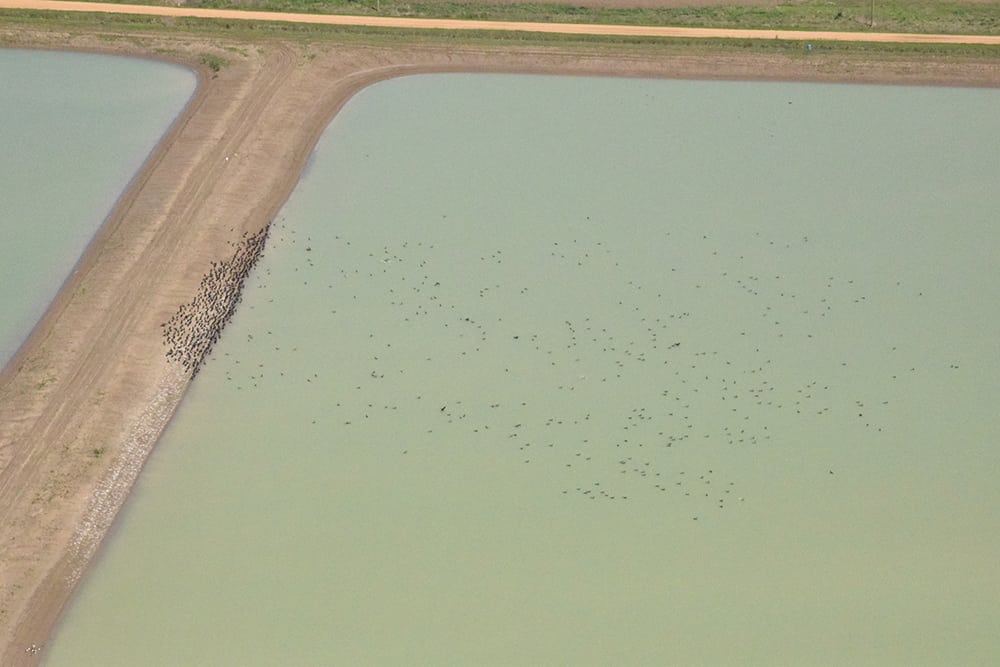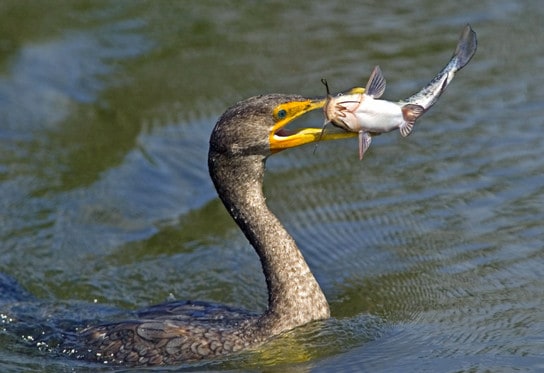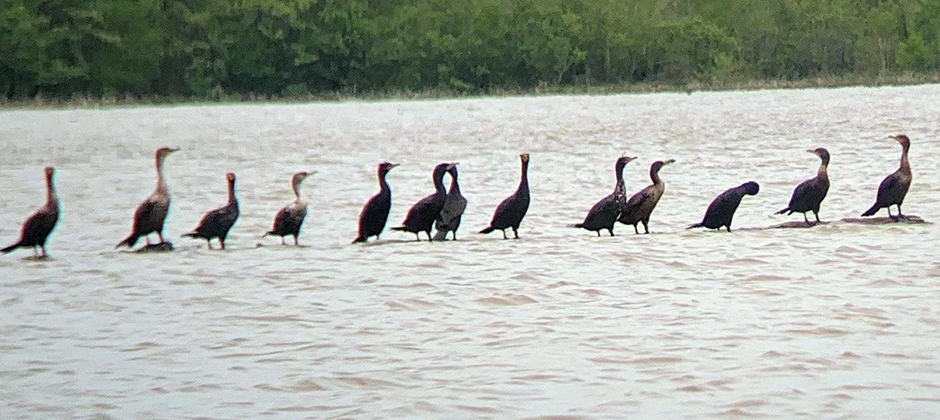Share this article
JWM: Cormorant control reduces fish farm predation
Cormorants spend less time eating catfish at aquaculture farms on the lower Mississippi River floodplain in years when lethal control measures are permitted.
“This is good evidence that having lethal control does affect how these birds distribute themselves,” said Paul Burr, a research associate at Mississippi State University and lead author of a study published recently in the Journal of Wildlife Management.
For years, Mississippi fish farmers have had problems with double‐crested cormorants (Phalacrocorax auritus). In this region thousands of cormorants descend on catfish ponds in a single winter, eating hundreds of metric tons of fish meant for the market.

As many as 75 cormorants can gather at a time catfish farms like this one. Credit: Paul Burr
The U.S. Fish and Wildlife Service has periodically allowed lethal control of cormorants to limit the amount of catfish they take from fish farms if farmers have already tried non-lethal methods. Burr and his co-authors wanted to learn more how the birds made use of natural wetlands in the area and fish farms.
He flew in a small plane to conduct surveys of the cormorants every two weeks for three years from October to April — the period when cormorants fly south for the winter from nesting grounds in Canada and the northern U.S. They started in October 2015 and finished their last survey in April 2018.
“I got sick a few times. It’s not very fun in that little plane,” Burr said.
Some 83% of the study area consisted of the artificial ponds, while 17% was natural wetlands. Burr and his colleagues found that the cormorants made more use of the natural wetland areas earlier, from October to January, after arriving from their northern breeding grounds. From February to their departure in April, the birds began to change their tastes.
“There was this shift from natural to aquaculture throughout the year,” he said.
The authors believe this may be an effort to fatten up for the cormorants’ northern migration.
“There’s a lot more fish in those catfish ponds, and they are stocked to higher density,” he said.
With regards to lethal control, they found that legislation seemed to have an impact on how birds distribute themselves between fish farms and natural wetlands. In 2015, the USFWS permitted fish farmers to shoot cormorants on aquaculture ponds. Lethal control stopped in 2016 but was allowed again in limited form in 2017 when farmers could apply for limited take.

A cormorant eats a juvenile catfish. Credit: J. Avery/Mississippi State University
The researchers found lethal control had a large effect on the numbers of cormorants they saw on the fish farms compared to natural wetlands. In 2015, when lethal control was allowed, the cormorants favored natural wetlands more than in years without lethal control, when farmers could only use hazing techniques, like shooting noisemakers, to scare the birds away. In 2016, when lethal control was banned, the cormorants occurred more often on aquaculture areas.
They also compared other possible factors. Cormorants tend to spend more time on aquaculture when it rains, for example, but in the years when there was lethal control, they stayed away more often from aquaculture, despite the greater precipitation that year.
Lethal control helps to reinforce non-lethal harassment, and ultimately alters cormorant behavior, Burr said, since fish farmers often miss. “They’re actually pretty hard to kill,” he said.
Despite the lethal control, which occurred from 1998 to 2016, breeding bird surveys in Canada and the U.S. Midwest show double-crested cormorant populations have been increasing. While some of this is likely due to the banning of pesticides like DDT, the cormorant population might be artificially bolstered by these catfish farms.
“It has potentially helped them,” Burr said. Cormorants normally migrate to the coastal areas for the winter, but with the rise of fish farms, more and more of the birds are staying on the Mississippi floodplain, he said.
This article features research that was published in a TWS peer-reviewed journal. Individual online access to all TWS journal articles is a benefit of membership. Join TWS now to read the latest in wildlife research.
Header Image: Cormorants sit on a log in the Mississippi River floodplain. Credit: R. Middleton NWRC








